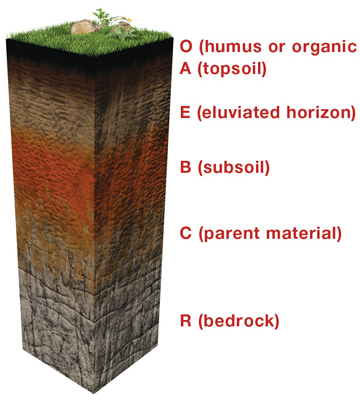Soil contains the rich pool of microbial diversity with bacteria, fungi, and viruses. Different layer of soil acting as microbial mats in nature. Since from last 100 years climatic conditions are changing continuously due to human interference in nature. Microbial survival points are very critical due to change in environmental conditions flora and fauna of the soil also changed. These microbes play important role in global biogeochemical cycles (nitrogen, carbon and phosphorous cycle). Scientist reports the microbial compositions in headwater riparian wetlands and found that wetland soil microbial abundance and community composition varied as function of landscape metrics as mediated through on site edaphic properties.
Soil structure and Microorganisms
Arrangement and organization of primary and secondary soil particles is known as soil structure. Which is mainly responsible for the amount of water and air present in soil. Water and air affected the microbial communities and behavior in soil. Soil layers are approximately parallel to the land surface and several layers may evolve simultaneously over a period of time. In soil science terminology these layers are called horizons. Microbes interacted with each other during different climatic conditions and established the community. Each of the community play important role in large environmental processes.
Effect of climate change on soil biology
Global change is diversifying species prorating and thus communication among organisms.
Microorganism live in contact with thousands of other species, few of them are beneficial and others pathogenic, some which have little to no effect in complex communities. Since natural microbial communities are composed of microorganisms with very different life history traits and dispersal ability it is unlikely they will all respond to climatic change in a similar way. If we see the scientific research papers we can conclude that their is less attention on the soil microbial communities under climatic conditions whereas in plant-pollinator and plant-herbivore interactions under global change have been relatively well described. Soil microorganisms (bacteri and fungi) regulate nutrient transformations, provide plants with nutrients, allow co-existence among neighbors, and control plant populations, changes in soil microorganism-plant interactions could have significant ramifications for plant community composition and ecosystem function. Soil and litter microbial communities are responsible for the majority of decomposition and nutrient mineralization in terrestrial ecosystems and their abundance, community structure, and activity are often directly influenced by abiotic factors such as temperature and precipitation At present we need to know how climatic change affects soil microbes and soil microbe-plant interactions directly and indirectly, and which type of emerging and exciting questions and areas for future research, ramifications changes in these interactions may have on the composition and function of ecosystems.
Methods to study the soil microbial community
To know the environmental effect on soil microbiology we need to know about the recent techniques and development of more techniques for this type of analysis. For coomunti analysis Denaturant gradient gel electrophoresis (DDGE) is a technique to know the total bacterial and fungal population on the basis of their conserved sequences (16S rDNA for bacteria and ITS region sequences for fungi). On the basis of metabolites present in soil we can also identify the group of microorganism from the soil layers. Gas chromatography mass spectroscopy (GC-MS) is the popular technique for the identification of complete metabolites from the layers.
Engineering tools for soil analysis
If we know the compositions of the soil than we can analyze which types of the soil components affected by change in temperature, pH and excess of rain. Now a days different techniques of civil engineering can be applied for soil component analysis. Soil mechanics would be interpret exactly how much clay particles, nutrients, physical forces are responsible for the environmental changes. Because these are the important factors for the soil microbial communities habitat. Even an small component can change the microflora of the soil.
Future Research Plan
Soil biology is critical in all aspect of the life its responsibility of scientist to know more about the soil biology and effect of change in climatic conditions on microbial community in soil. Day by day our environment is changing, increased temperature, alkalinity, acidity, unexpected cloud bursts are the examples of the climate change. Microbes are the part of the environment which cannot be seen by naked eyes but their importance to regulate the various biogeochemical cycles not ignored. Various strains of nitrogen fixing bacteria, waste matter decomposing fungi playing their key roles from past many decades. It is possible due to environmental stress we have lost many of the beneficial microbial strains. Future research on microbiology, chemistry and engineering will help the scientist to solve the problem and safe natural biological process.
